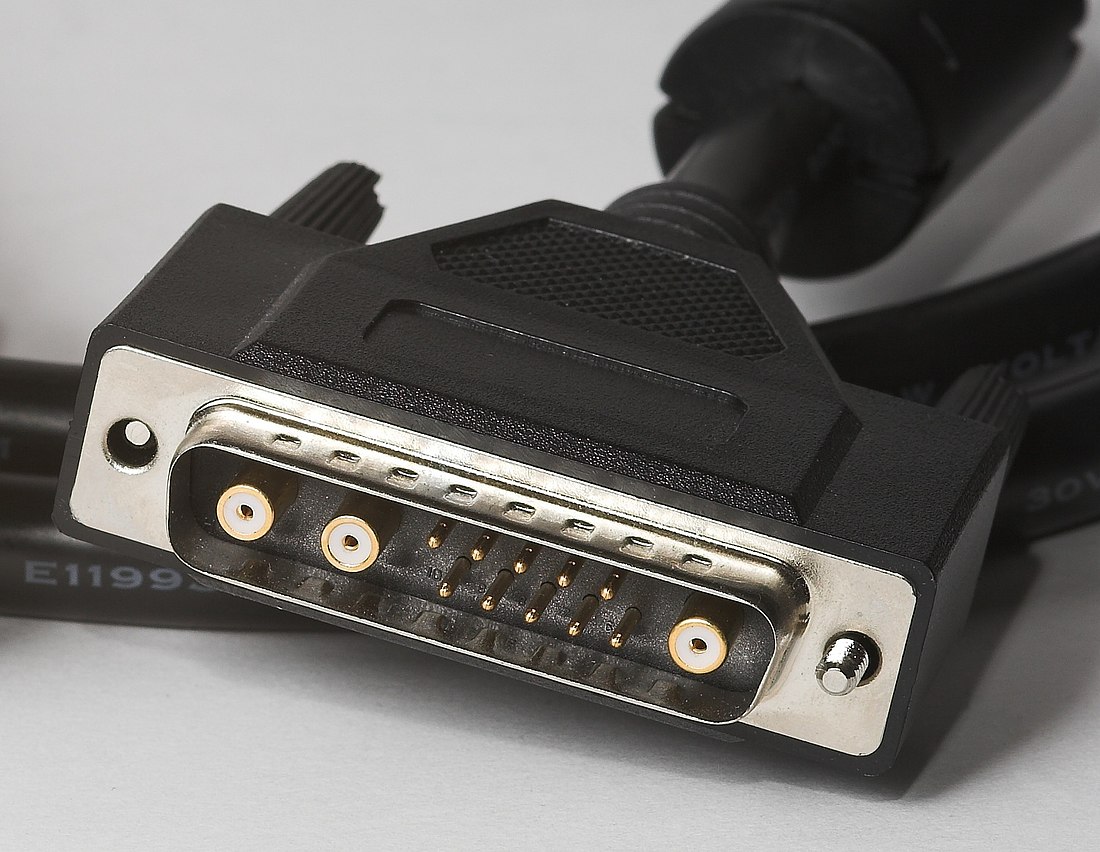DB13W3 (13W3) is a style of D-subminiature connector used for analog video interfaces. The 13 refers to the total number of pins, the W refers to workstation and the 3 refers to the number of high-frequency pins. The connector was something of a pseudo-standard for high-end graphical workstations from the early 1990s to the early 2000s.
 Male 13W3 plug | |||
| Type | Computer video connector | ||
|---|---|---|---|
| Superseded by | Analog interfaces such as VGA and DVI-A and digital interfaces such as DVI-D, HDMI and DisplayPort | ||
| General specifications | |||
| Hot pluggable | Yes | ||
| External | Yes | ||
| Video signal | Analogue RGB or monochrome | ||
| Pins | 13 | ||
| Pinout | |||
 | |||
| Pin | Sun[1] |
SGI/ DCC[2] | |
| Pin 1 |
Ground/ DDC-SCL |
Monitor ID bit 3/ Data clock (SCL) | |
| Pin 2 |
Vertical sync/ NC |
Monitor ID bit 0/ Bi-directional data (SDA) | |
| Pin 3 |
Sense #2/ NC |
Composite sync/ Composite sync | |
| Pin 4 |
Sense ground/ DDC ground |
Horizontal drive/ Horizontal sync | |
| Pin 5 | Composite sync |
Vertical drive/ Vertical sync | |
| Pin 6 |
Horizontal sync/ DDC-SDA |
Monitor ID bit 1/ DDC (+5V input) | |
| Pin 7 |
Ground/ VSYNC |
Monitor ID bit 2/ DDC ground | |
| Pin 8 |
Sense #1/ NC |
Digital ground/ Ground | |
| Pin 9 | Sense #0 /NC |
Digital ground/ Ground | |
| Pin 10 | Composite ground |
Sync ground/ Ground | |
| A1 | Red | Red | |
| A2 |
Green (gray for monochrome) |
Green (gray for monochrome) | |
| A3 | Blue | Blue | |
Usage
Video
The 13W3 connector became something of a pseudo-standard for high-end graphical workstations from the early 1990s to the early 2000s.[3]: 176 [4][5]: 43 Among its primary users included Sun Microsystems, Silicon Graphics (SGI) and IBM (the latter for use with their RISC workstations),[3]: 176 [6]: 281, 305 as well as some displays from Apple,[7] NeXT and Intergraph.[6]: 286
Implementations of this connector in terms of pin-out varied widely, not only between different vendors but also between different families of workstations within the same company. This led to some complication for corporate buyers and service personnel of these workstations due to peripherals and accessories floating in the marketplace that offered these connectors while intended for only one family of workstations. The intentionally closed ecosystem of displays and peripherals for workstations prevented this from becoming a major issue;[3]: 176 nonetheless, some companies such as Mitsubishi, Eiki, and Samsung offered third-party displays (and even projectors) for such graphical workstations.[8]: 12 [9][4]
The 13W3 connector is no longer used with modern displays, having been considered a legacy connector since at least 2006. Among the last commercial products sold with the connector were KVM switches.[5] It was superseded for use with analog displays by the VGA connector, and as the display market has moved to digital flat panel displays that has in turn been replaced almost entirely by digital connections (DVI, HDMI, or DisplayPort).[3]: 177–181 [10]
Non-video

A variant of the DB13W3 connector, with high-current pins instead of the high-frequency pins used for video applications, is also used by some 3Com SuperStack Ethernet switches to carry DC power.[11]
It has also been used in various industrial appliances.
Specifications
The connector contains 10 standard signal pins and 3 larger positions that can be fitted with either special pins with two concentric contacts for coaxial cable or with special high-current pins. When used for video signals on the computer side, the pins are female but the coaxial connectors in the large positions are male. The coaxial connectors carry the video signal split into red, green/gray, and blue; the standard signal pins carry four grounds, three "sense" pins used to communicate with the monitor, vertical sync, horizontal sync, and a composite sync signal.

The 13W3 connector can be converted into a standard VGA connector or DVI-A using commonly available cables and adapters. This allows multisync monitors, which became prevalent in personal computing in the late 1980s, to be used with these workstations as long as they are sync-on-green compatible. Likewise, later-generation Sun monitors, which began supporting multisync in 1998, can be connected via similar cables to personal computers.
Even though 13W3 is a standard connector, the sync signals are maintained on different pins based on the display and system. Sun, Intergraph, IBM and SGI each use different pin configurations for the monitor sense ID and sync signals. Sun and SGI each even have two different pin configurations: with and without Display Data Channel support. The Sun DDC connector was used at least on the UPA graphics adapters (Creator 3D, Expert 3D) and for their corresponding monitors (GD5410, GD5510). This can make matching the correct cable to the monitor virtually impossible. Many monitors with 13W3 connectors do not support separate sync as supplied on most PC systems. Other converters exist to allow connecting newer monitors with VGA connectors to the older systems and workstations. The most popular of these[according to whom?] is a cable with a series of DIP switches built in that can be used to set the sync signals.
See also
References
External links
Wikiwand in your browser!
Seamless Wikipedia browsing. On steroids.
Every time you click a link to Wikipedia, Wiktionary or Wikiquote in your browser's search results, it will show the modern Wikiwand interface.
Wikiwand extension is a five stars, simple, with minimum permission required to keep your browsing private, safe and transparent.
